Datsun Truck
| Datsun Truck | |
|---|---|
 | |
| Overview | |
| Manufacturer | Nissan |
| Production | 1955-1986 (as a Datsun) |
| Model years | 1956-1986 |
| Body and chassis | |
| Class | Compact pickup truck |
| Layout | Front engine, rear-wheel drive |
| Chronology | |
| Predecessor | Datsun 6147 |
| Successor | Nissan Hardbody Truck (D21) |
The popular and economical Datsun/Nissan compact pickup truck was produced in Japan from 1955 and has been sold in large numbers across all continents. Modern versions of this vehicle are still in production around the world, currently with the Frontier and Navara names. In Japan, it was exclusive to Nissan Bluebird Shop locations.
Predecessors
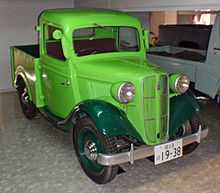
The Datsun truck line began with the Model 13 Truck of April 1934. A series of small trucks based on their passenger car counterparts, the 14, 15, and 17 continued to be built until early 1944. This was followed by the near identical post-war Datsun 1121 (1946) and 2124 (1947-1949). In 1949 the 3135 took over, followed by next year's Datsun 4146. In 1951 the 5147 appeared, which was succeeded two years later by the 6147. Aside from a bigger and more modern engine (with 25 PS or 18 kW), the Datsun 6147 was nearly identical to the prewar type 15 truck. This was built until the 1955 introduction of the all new 120-series truck.
Datsun 120/220
| Datsun 120/220 | |
|---|---|
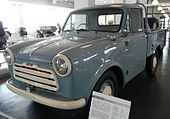 Datsun 220 | |
| Overview | |
| Production | 1955-1960 |
| Model years | 1956-1960 |
| Assembly | Kyūshū, Japan |
| Body and chassis | |
| Body style |
|
| Layout | Front engine, rear-wheel drive |
| Powertrain | |
| Engine | |
| Transmission | 4-speed manual |
| Chronology | |
| Predecessor | Datsun 6147 |
| Successor | Datsun 320 |
The Datsun 120 was a load carrying bodystyle version of the Datsun 1000 sedan, and was introduced in January 1955 as the first Datsun truck with up-to-date styling. The 120 series was based on the Datsun 110 series. Delivery van, panel van (120 only), and double cab versions were available. Until 1959 it used the 25 hp, 860 cc Nissan D10 engine with a four-speed floor shift (column shift for the 123 and later versions) manual transmission. During its six years in production six main models were built: 120 (Jan. to Dec. 1955), 122 (Dec. 1955 to May 1956) and 123 (Jun. 1956 to Sep. 1957). For reasons unknown, Nissan skipped the 121 designation. After the introduction of the re-engined 220-series truck, a modernized low-cost option, the Datsun 124, was introduced in October 1957. It continued to use the same bodywork and engine as the 123, although with less chrome trim.[1] This was then followed by the re-engined Datsun 125 in 1959 and finally by the Datsun 126 in 1960. While the 124 was still powered by the D10, the 125 and 126 received an improved version of this engine called the B-1, rated at 27 PS.
220 series

In November 1957 the type 220 was introduced. Largely unchanged in appearance from the 120-series, which continued to be built as a cheaper version, it was produced from 1957 to 1961. During this time four models were produced: 220 (1957–1958), 221 (1958-1959), 222 (1960), and 223 (1961). The chassis was based on the 210 series sedans. Two engines were available: the 37 hp Nissan C engine, and the 48 hp Nissan E engine. The E engine was originally only used in models sold on the export market. The 223 was powered by a new engine, the Nissan E-1, rated at 60 hp. The 220 was the first Datsun truck to be equipped with a 12 volt electrical system. Double cab and delivery van versions were available. Side badges were "Datsun 1000" or "Datsun 1200". The 223 also had a round "60 HP" badge. There was also a round badge on the dashboard that said "Datsun 1000" or "Datsun 1200", depending on the engine. The 223 had a revised chassis and suspension system. The front I-beam suspension used on the 220, 221 and 222 was replaced with an independent front suspension with torsion bars. As a low cost option, a lightly changed model of the D10 sidevalve-engined predecessor was introduced in October 1957 (the Datsun 124), followed by the Datsun 125 in 1959 and finally the Datsun 126 in 1960. The 125 and 126 were powered by the B-1, an improved version of the D10 with 27 hp.
In 1958 the Datsun 220 was exhibited at the Los Angeles Auto Show. American exporteds begun soon thereafter. It was the 220 series that established Datsun in the American market.
Datsun 320
| Datsun 320 | |
|---|---|
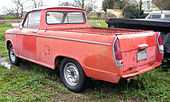 1964 Datsun NL320 | |
| Overview | |
| Production | 1961-1965 |
| Model years | 1962-1965 |
| Assembly | Kyūshū, Japan |
| Body and chassis | |
| Body style |
|
| Layout | Front engine, rear-wheel drive |
| Powertrain | |
| Engine | 1.2 L E-1 I4 |
| Chronology | |
| Predecessor | Datsun 223 |
| Successor | Datsun 520 |
In August 1961 the new 320 series was released. It was produced until 1965 in three series (320-322). The 320 series was largely inherited from the earlier 120/220, although with clear improvements to body and frame. It used the Nissan E-1 engine. This engine produced 60 PS.
All Datsun trucks kept the A-arm torsion bar front suspension with leaf-sprung rear ends and had a 1/2 ton load capacity. Rear end gearing was a low 4.875:1 along with a four-speed transmission; as a result, the 320 was not freeway friendly above 60 mph. Fender emblems showed "Datsun 1200" and "60 HP" ("55ps" for models sold in Japan) with a "Datsun" emblem on the front nose of the hood.
Available bodystyles include a single cab "truck" (320), a longer wheelbase single cab truck (G320), a double cab "pickup" with flush sides (U320), and a three-door "light-van" (V320). Though described (and taxed) as a van in the Japanese market, the V320 is essentially a two-door station wagon. The 320 came in two cab and bed versions: Regular, and as the NL320 "Sports Pick-Up" (1963–65) variation which is a rarer (around 1,000 produced) version with the cab and bed of a one-piece design. Its back half is greatly different than that of the standard, separate bed 320 pick-up.

Bed and luggage space were in addition to the expansion, with the support of the market characteristics and the robust chassis engine was easy to handle, it was a best seller in the truck market segment.
The chassis was also a sales hit 310 in the reinforcement of the type Datsun Bluebird 310, a variation of the same series, in which the X-members plus a reinforcement of the Fairlady roadster of the S310-type CSP311. It was also used for the new Silvia coupé.
In 1964 the 320 underwent minor changes. After having adding the failed Light Stout, Toyota took over Hino's Briska and then continued with the Hilux. Mazda also competed in this segment, with the Mazda B-Series. In 1960, Nissan assumed operations of the Minsei Diesel Industries, Ltd., renaming the company as Nissan Diesel Motor Co., Ltd.
Datsun 520
| Datsun 520, 521 | |
|---|---|
 Datsun 1300 | |
| Overview | |
| Production | 1965-1972 |
| Model years | 1966-1972 |
| Assembly | Kyūshū, Japan |
| Body and chassis | |
| Body style |
|
| Layout | Front engine, rear-wheel drive |
| Powertrain | |
| Engine | |
| Dimensions | |
| Wheelbase | |
| Chronology | |
| Predecessor | Datsun 320 |
| Successor | Datsun 620 |
The Datsun 520 was built from 1965 until 1969 (the 420 designation was skipped). It used the new 1.3 litre, 67 hp Nissan J13. In 1965 and 1966 the 520 had two single headlights. For 1967, the 520 was slightly redesigned and had twin headlights. This design was carried on until the end of 520 production. Single cab (520), LWB Single cab (G520), Double cab (U520) and delivery van (V520) versions were available. "G" was used to identify the long wheelbase versions. The fender emblems said "Datsun 1300". A grille emblem was added in 1966 and simply said "D". In late 1967 a slightly altered model appeared, now with a slightly changed chrome grille with a distinct frame.[3]
The 521 was the facelifted version of 520, with a so-called "flat-deck" style. This meant a flattened bonnet and front fenders as well as a new grille design.[2] It used the Nissan J engines (the previously mentioned J13 or the larger J15, rated at 77 hp) and later had a 95 PS (70 kW) Nissan L16 engine, always with a straight rear axle. The 520 strongly resembles a Datsun 410/411 from the front, since it shares most sheet metal with that car. The fender emblems said "Datsun 1300", "Datsun 1500" or "Datsun 1600" (depending on engine fitment). Van/delivery van (V521) and double cab (U521) versions were available. It was manufactured from 1969–1972, preceded by the 520 and followed by the 620. The 521 was the first compact half-ton pickup sold in the American market, in 1968 [citation needed].
|
Datsun 620
| Datsun 620 | |
|---|---|
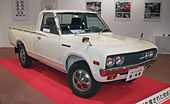 Datsun 620 | |
| Overview | |
| Also called | Yue Loong 753 (TW) |
| Production | 1972-1979 |
| Model years | 1973-1979 |
| Assembly | Kyūshū, Japan |
| Body and chassis | |
| Class | Compact truck |
| Body style |
|
| Layout | Front engine, rear-wheel drive |
| Powertrain | |
| Engine | |
| Transmission | |
| Dimensions | |
| Wheelbase | |
| Chronology | |
| Predecessor | Datsun 521 |
| Successor | Datsun 720 |
In February 1972, the Datsun 620 truck was released and was in production until 1979. It was a regular cab truck (a longer "King Cab" version was released in 1977) and two wheelbases were offered, for a total of six different models. There was also a delivery van version, offered only in Japan. Naturally there were bare chassis models, and many importers installed locally made flat decks. There was also the U620, which is a crew cab "Utility" version. It uses a shorter, fully integrated bed to allow comfortably seating four people. The U620 was essentially a 620 pickup from the doors forward, with the bed and rear end being the only difference. Nissan continued the strong rhythms and styling of its previous vehicles, with a shoulder "wing line" or "Bullet Side" accent running alongside the vehicle. In most of the world the 620 was equipped with the J15, producing 77 hp (57 kW) and with a top speed of 135 km/h (84 mph).[5] A 2.2 liter diesel engine with 66 hp (49 kW) was later made available in many markets.
The 620 was also the first Datsun pickup truck to be available with a longer "King Cab" passenger compartment (called "Custom" in Japan). This utilized the bed from the normal 620 truck, but has a cabin stretched by 24 cm (10 in).[6]
In North America, the 620 continued to use the Nissan L engine. The 1972 and 1973 models were powered by the L16 engine (96 hp), the 1974 model used the L18 engine (100 hp), and the 1975 through 1979 models used the L20B engine (110 hp). The standard transmissions were the F4W63 four-speed (1972 and 1973) and F4W71 four-speed (1974 to 1979). In 1977, the optional FS5W71B five-speed manual transmission became available. The 3N71 three-speed automatic became available as an option in mid-1972. This was the first series to offer an automatic transmission as an option (all model series before the 620 only had manual transmissions). Final drive gearing was 4.375:1. Side badges read "DATSUN 1600" or simply "DATSUN". The grille badge was two colored stripes (one red and one blue) behind the word "DATSUN". The 620 was known for its durability and weather resistance despite its small size, along with engines known for their reliability. As a result, the 620 was competing with the larger American pickup trucks, which in turn gave Datsun a strong reputation in the United States. A number of innovations were introduced with the 620: first long-bed (1975), emission control technology called (NAPS (Nissan Anti Pollution System)) in 1975, first extended-cab (1977), front disc brakes (1978), and electronic ignition (1978).
The 620 was redesigned slightly for 1978, with changes to grille and front bumper. A four-door crew cab variant was also offered in some markets.
|
Datsun 720
| Datsun 720 | |
|---|---|
_01.jpg) 1983-84 Datsun 720 crew cab | |
| Overview | |
| Also called |
|
| Production | 1980-1986 |
| Assembly |
|
| Body and chassis | |
| Body style | |
| Layout | Front engine, rear-wheel drive / four-wheel drive |
| Powertrain | |
| Engine | |
The Datsun 720 came in regular cab and "King Cab" models, with regular and long bed options. The King Cab proved very popular. There was also a 4-door variant offered in some overseas markets. A covered utility body style like that of the early Toyota 4Runner was also available as an aftermarket conversion by a company called Matrix3. This was available as a "dealer option" from 1984–1986 and was called the Bushmaster. In mid-1986 a factory-built version was introduced and was named Pathfinder. Other US model variations besides KC (King Cab) were the GL (long bed), DX (deluxe), ST (sport truck aka "Li'l Hustler" shortbed) and Cab-and-Chassis models (2wd only).
The 720 was manufactured in the newly built Smyrna, Tennessee plant from 1983.5 to 1986.
Early (1980–1983) models had single wall beds with outside rolled lips and rope ties, two faux hood vents (some had real vents), and tail lights on the lower rear valance (similar to the 620).
For a limited period, 1983.5-1984 models built in the USA had the single wall beds with rope ties, yet used tail lights on the rear bed corners with amber turn signals over the red stop/tail lights while the backup lights remained under the tailgate. The front end underwent transformation as well, with a larger grille, bumper, and corner lights. There was also a revised dashboard with round instead of square gauges. At the same time, the regular cab was lengthened slightly and the air extractor vents behind the cab doors changed from the high "flag" look to long, narrow ones that matched the height of the window opening. The cabs of the King Cab versions were unchanged.
Finally, the late model trucks produced from 1985 - 1986.5 (first half) utilized double wall, smooth sided beds, with revised tail lights on the corners which resembled those on Chevrolet/GMC S-series trucks. Some overseas models continued with the early style beds. Model years 1986.5 (second half) and later were called Nissan Hardbody Trucks, chassis code D21.
In most parts of the world (other than North America), one could purchase a four-door crew cab version of the 720. The Datsun 720 was available in both 2WD and 4WD configurations, the latter having a divorced transfer case. The long wheelbase 2WD trucks (King Cab, short bed, and regular cab, long bed) had a two-piece driveshaft with a center support bearing.


In 1979.5 and 1980, models were powered by Datsun's 2.0L carbureted L20B I4 engine, but soon after switched to the Nissan NAPS-Z engine line for 1981 (Z20S). "NAPS (Nissan Anti Pollution System)" was the terminology Nissan used to describe their pollution control technology as a result of emission regulation laws having been enacted in Japan starting in 1975. In the Middle East it was powered by Datsun's 1.8 L carbureted L18 engine. The 1981-1982 models used the Z22 carbureted 2.2 L engine and an optional SD22 diesel of the same displacement. In mid-1983 Nissan introduced the Z24 2.4 liter twin spark four-cylinder motor, producing 103 hp (77 kW), 2.3 L SD23 OHV diesel four, and the SD25 diesel; this happened at the same time that the 720 series was marketed as a Nissan (the Datsun name, which had disappeared entirely after 1984, was now only seen below the Nissan name on the left corner of the tailgate). The diesel engines were sourced from the Nissan Diesel division, which Nissan Motors acquired in 1960. In the American market the diesel engine was only available in the 2WD 720 (from 1982 to 1985). The Z24 was upgraded to Z24i single-point fuel-injection (optional) for the 1986 models. Buyers in the rest of the world also received versions with the smaller 1.5 L J15, 1.6 L J16 or 1.8 L L18 carbureted engines. The 720 Series was never available with any of the Z22E or Z20E multi-port fuel injected engines. These engines are, however, easy to adapt and integrate into the chassis and can be found with the genuine appearance of being original equipment.
The United Kingdom only received the longer wheelbase, as a standard bed 1-tonner with the L18 engine or as the four-wheel drive 2.2 litre King Cab with 96 hp (72 kW).[7]
External links
| Wikimedia Commons has media related to Datsun Truck. |
- Nissan DATSUNTRUCK
- Nissan DATSUNPICKUP
- NISSAN HERITAGE COLLECTION
- http://www.pickuptruck.com/html/history/nissan_segment1.html
- http://trucks.about.com/cs/classicgallery/a/datsun_trucks.htm
- http://rohling.com/auto/pl521/
- http://www.datsunhistory.com/
- http://www.datsun320.com
- http://olddatsuns.com (Datsun 620)
References
- ↑ Bent, Alan. "1959 Datsun 220 Model". Earlydatsun.com. Retrieved 2012-06-27.
- ↑ 2.0 2.1 2.2 Bent, Alan. "1968 Datsun 521 Truck". Earlydatsun.com. Retrieved 2012-06-27.
- ↑ Bent, Alan. "1968 Datsun 520 Truck". Earlydatsun.com. Retrieved 2012-06-27.
- ↑ 4.0 4.1 New Datsun Pickup 1500 (brochure), Japan: Nissan Motor Co, 1972, p. 2, L61E
- ↑ Datsun One Ton Utility (brochure), New Zealand: Nissan Motor Distributors (NZ), 1975, p. 4
- ↑ 自動車ガイドブック [Japanese Motor Vehicles Guide Book] (in Japanese) (Japan: Japan Automobile Manufacturers Association) 25: 218. 1978-10-10. 0053-780025-3400.
- ↑ Nissan Commercial Vehicle Range 1984 (brochure), Worthing, UK: Nissan UK Limited, July 1984, pp. 5–6, S24.25m.F923.7.84
| Nissan light truck timeline, North American market, 1980s–present | |||||||||||||||||||||||||||||||||||
|---|---|---|---|---|---|---|---|---|---|---|---|---|---|---|---|---|---|---|---|---|---|---|---|---|---|---|---|---|---|---|---|---|---|---|---|
| Type | 1980s | 1990s | 2000s | 2010s | |||||||||||||||||||||||||||||||
| Model year | 0 | 1 | 2 | 3 | 4 | 5 | 6 | 7 | 8 | 9 | 0 | 1 | 2 | 3 | 4 | 5 | 6 | 7 | 8 | 9 | 0 | 1 | 2 | 3 | 4 | 5 | 6 | 7 | 8 | 9 | 0 | 1 | 2 | 3 | 4 |
| Mini crossover | Juke | ||||||||||||||||||||||||||||||||||
| Compact crossover | Rogue | Rogue | |||||||||||||||||||||||||||||||||
| Rogue Select | |||||||||||||||||||||||||||||||||||
| Mid-size crossover | Murano | Murano | |||||||||||||||||||||||||||||||||
| Pathfinder | |||||||||||||||||||||||||||||||||||
| Compact SUV | Xterra | Xterra | |||||||||||||||||||||||||||||||||
| X-Trail | X-Trail | ||||||||||||||||||||||||||||||||||
| Mid-size SUV | Pathfinder | Pathfinder | Pathfinder | ||||||||||||||||||||||||||||||||
| Full-size SUV | Armada | ||||||||||||||||||||||||||||||||||
| Mini MPV | Cube | ||||||||||||||||||||||||||||||||||
| Compact MPV | Stanza Wagon/Multi | Axxess | |||||||||||||||||||||||||||||||||
| Minivan | Van | Quest | Quest | Quest | Quest | ||||||||||||||||||||||||||||||
| Van | NV200 | ||||||||||||||||||||||||||||||||||
| NV | |||||||||||||||||||||||||||||||||||
| Pickup | Datsun Truck | Hardbody Truck | Frontier | Frontier | |||||||||||||||||||||||||||||||
| Titan | |||||||||||||||||||||||||||||||||||
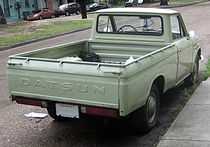



_(front)%2C_Kuala_Lumpur.jpg)